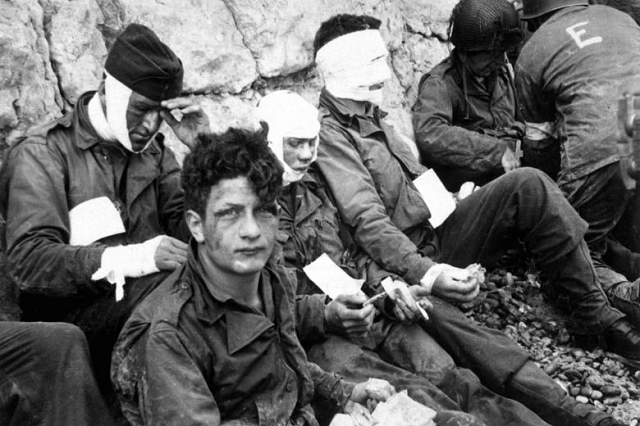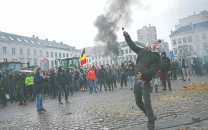How the longest day unfolded
Here is a chronology of the historic event that heralded the Nazi defeat

American troops of the 16th Infantry Regiment, injured while storming Omaha Beach, waiting to be evacuated to a field hospital, in Normandy, France, on June 6, 1944. PHOTO: U.S. ARMY
Here is a chronology, in local time, of the historic event that heralded the Nazi defeat.
9:15 pm: The BBC's Radio Londres, which broadcasts from London to Nazi-occupied France, airs the opening lines of Paul Verlaine 1866 poem "Chanson d'Automne" as a signal to alert French resistance fighters on the ground that an invasion is imminent.
10:00 pm: British-based airborne troops board their planes.
00:05 am: The Allied bombardment of the French coast starts. By dawn more than 5,000 tonnes of bombs have been dropped from Le Havre to Cherbourg.
00:15 am: The first gliders start to land behind German lines, carrying troops and equipment. Some soldiers are impaled on spikes erected by the Germans on the beaches, or become stuck in swamps.
00:20 am: In the first Allied D-Day victory, Pegasus Bridge is captured by the British 6th Airborne Division, snapping a vital link to the German artillery on the beach behind.
00:50 am: Under heavy German fire, thousands of British and US troops begin parachuting in. The drops continue until around 2:30 am, with about 23,000 landing.
1:15 am: German units about 300 kilometres (180 miles) away are alerted to the invasion but German leaders prove difficult to reach. The commander of the German forces, Field Marshal Erwin Rommel, is on leave at home for his wife's birthday.
2:30 am: British paratroopers liberate the town of Ranville, north of Caen.
4:30 am: US troops fly the American Stars and Stripes from a church in Sainte-Mere-Eglise.
5:00 am: Aides to Nazi leader Adolf Hitler decide the reports of an invasion are not credible and do not wake him.
5:58 am: The sun rises and the tide is low. Operations begin to land US troops on Utah and Omaha beaches, with the British and Canadian forces going to Gold, Juno and Sword beaches.
6:45 am: The first boats carrying the US soldiers reach Omaha, which is dominated by high cliffs defended by the German 352nd Infantry Division. More than 34,000 US soldiers land but 2,500 will be dead or wounded by the end of the day.
7:30 am: Around 53,000 British soldiers start arriving at Gold and Sword, 1,000 being killed or wounded.
07:45 am: About 23,250 US soldiers begin landing at Utah Beach, 200 later killed or wounded.
07:55 am: More than 21,000 Canadian and British soldiers begin arriving at Juno. Nearly 900 Canadians are killed or wounded.
9:30 am: Commander of the operation, US General Dwight Eisenhower, announces the launch of Operation Overlord.
10:00 am: Hitler is awakened and learns of the D-Day landings.
The order is given at Omaha Beach to quit the beach and attack the inland plateau.
12:00 am: Britain's wartime leader Winston Churchill announces the landings to parliament.
3:00 pm: As Allied troops advance, Hitler gives the order to the 12th SS Hitlerjugend and the Lehr tank divisions to deploy along the coast, even though he remains convinced the invasion is a bluff. Rommel sets off for Normandy.
6:00 pm: According to the BBC, French General Charles de Gaulle, who is in exile in England, says the battle for France has begun.
8:00 pm: There are new Allied bombardments on major towns, marking the next phase of the long, hard battle for Normandy.
Midnight: In one day, 156,000 Allied troops and 20,000 vehicles have invaded Nazi-occupied northern France.
Allied losses for the day are put at nearly 11,000 dead, wounded or missing. German losses for the day have not been established in detail.
Thousands of French civilians are also casualties.



















COMMENTS
Comments are moderated and generally will be posted if they are on-topic and not abusive.
For more information, please see our Comments FAQ